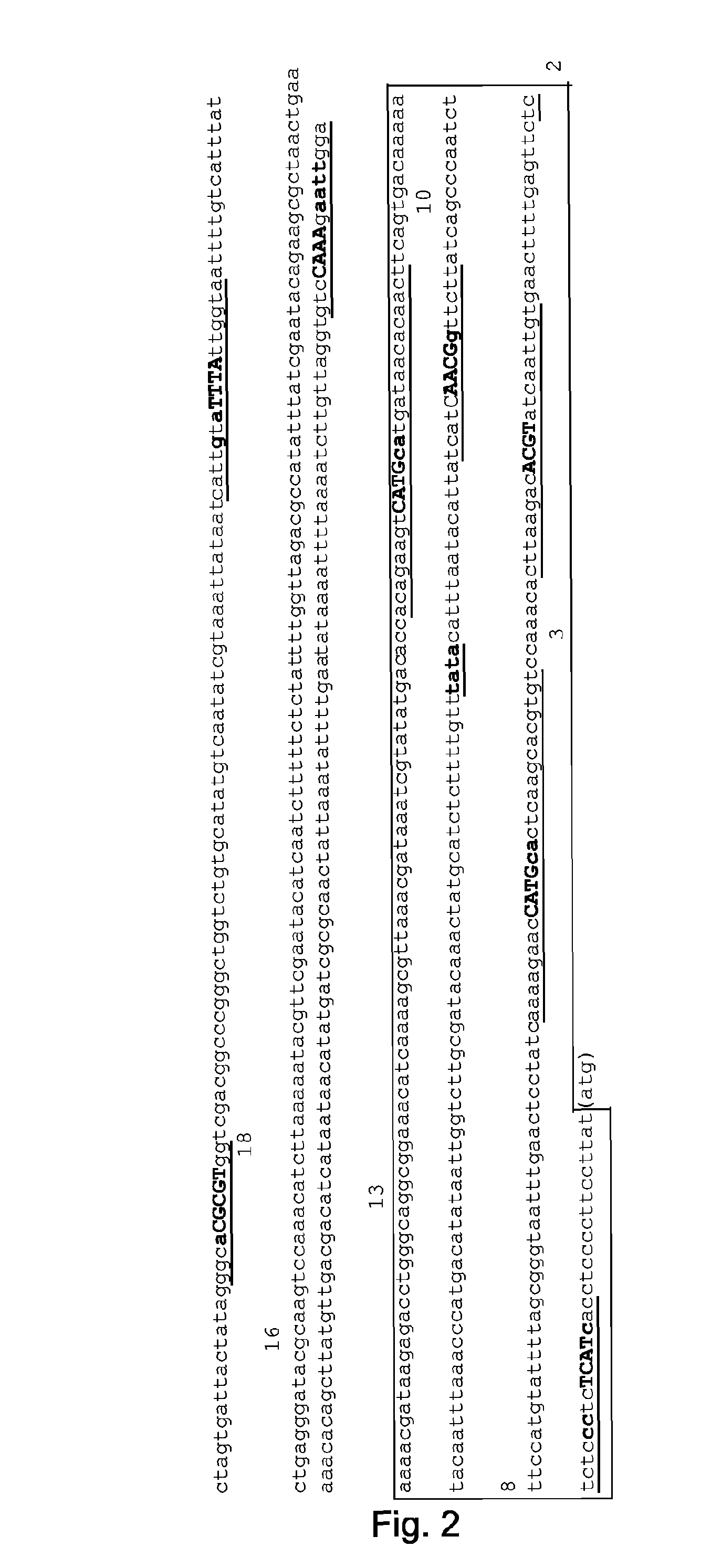Expression cassettes for seed-preferential expression in plants
a cassette and plant technology, applied in the field of plant expression cassettes, can solve the problems of inability to work, isolate a promoter from its natural environment, and use heterogeneous gene expression, and achieve the effects of preventing read-through transcription, increasing expression levels, and constant mrna transcript length
- Summary
- Abstract
- Description
- Claims
- Application Information
AI Technical Summary
Benefits of technology
Problems solved by technology
Method used
Image
Examples
example 1
Generation of Transgenic Plants
[0457]1.1 Generation of Transgenic Arabidopsis thaliana Plants
[0458]For generating transgenic Arabidopsis plants Agrobacterium tumefaciens (strain C58C1-[pMP90]) is transformed with the various promoter::GUS vector constructs (see below). Resulting Agrobacterium strains are subsequently employed to obtain transgenic plants. For this purpose a isolated transformed Agrobacterium colony is incubated in 4 ml culture (Medium: YEB medium with 50 μg / ml Kanamycin and 25 μg / ml Rifampicin) over night at 28° C. With this culture a 400 ml culture of the same medium is inoculated and incubated over night (28° C., 220 rpm). The bacteria a precipitated by centrifugation (GSA-Rotor, 8.000 U / min, 20 min) and the pellet is resuspended in infiltration medium (1 / 2 MS-Medium; 0.5 g / l MES, pH 5.8; 50 g / l sucrose). The suspension is placed in a plant box (Duchefa) and 100 ml SILVET L-77 (Osi Special-ties Inc., Cat. P030196) are added to a final concentration of 0.02%. The pl...
example 2
Growth Conditions for Plants for Tissue-Specific Expression Analysis
[0463]To obtain 4 and 7 days old seedlings, about 400 seeds (Arabidopsis thaliana ecotype Columbia) are sterilized with a 80% (v / v) ethanol:water solution for 2 minutes, treated with a sodium hypochlorite solution (0.5% v / v) for 5 minutes, washed three times with distillated water and incubated at 4° C. for 4 days to ensure a standardized germination. Subsequently, seeds are incubated on Petri dishes with MS medium (Sigma M5519) supplemented with 1% sucrose, 0.5 g / l MES (Sigma M8652), 0.8% Difco-BactoAgar (Difco 0140-01), adjusted to pH 5.7. The seedlings are grown under 16 h light / 8 h dark cyklus (Philips 58W / 33 white light) at 22° C. and harvested after 4 or 7 days, respectively.
[0464]To obtain root tissue, 100 seeds are sterilized as described above, incubated at 4° C. for 4 days, and transferred into 250 ml flasks with MS medium (Sigma M5519) supplemented with additional 3% sucrose and 0.5 g / l MES (Sigma M8652),...
example 3
Demonstration of Expression Profile
[0474]To demonstrate and analyze the transcription regulating properties of a promoter of the useful to operably link the promoter or its fragments to a reporter gene, which can be employed to monitor its expression both qualitatively and quantitatively. Preferably bacterial β-glucuronidase is used (Jefferson 1987). β-glucuronidase activity can be monitored in planta with chromogenic substrates such as 5-bromo-4-Chloro-3-indolyl-β-D-glucuronic acid during corresponding activity assays (Jefferson 1987). For determination of promoter activity and tissue specificity plant tissue is dissected, embedded, stained and analyzed as described (e.g., Bäumlein 1991).
[0475]For quantitative β-glucuronidase activity analysis MUG (methylumbelliferyl glucuronide) is used as a substrate, which is converted into MU (methylumbelliferone) and glucuronic acid. Under alkaline conditions this conversion can be quantitatively monitored fluorometrically (excitation at 365 n...
PUM
| Property | Measurement | Unit |
|---|---|---|
| Tm | aaaaa | aaaaa |
| temperatures | aaaaa | aaaaa |
| nucleic acid sequence | aaaaa | aaaaa |
Abstract
Description
Claims
Application Information
 Login to View More
Login to View More - R&D Engineer
- R&D Manager
- IP Professional
- Industry Leading Data Capabilities
- Powerful AI technology
- Patent DNA Extraction
Browse by: Latest US Patents, China's latest patents, Technical Efficacy Thesaurus, Application Domain, Technology Topic, Popular Technical Reports.
© 2024 PatSnap. All rights reserved.Legal|Privacy policy|Modern Slavery Act Transparency Statement|Sitemap|About US| Contact US: help@patsnap.com









